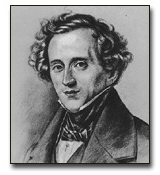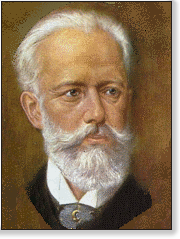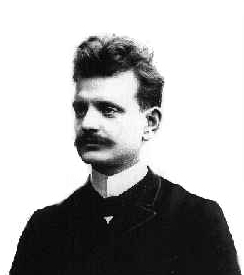
born Hamburg, 3 February 1809
died Leipzig, 4 November 1847
Overture to a Midsummer Night's Dream Op. 21 (1826)

-
When he was 17 years old it took Mendelssohn scarcely a month to write his Midsummer Night's Dream Overture. After two private performances at the end of 1826 it was premiered on 20 February 1827 in Stettin, and since then the success of this work (to which was added 15 years later the incidental music for two sopranos, women's chorus and orchestra) has remained constant.
The second of four highly gifted children of a wealthy family (their father Abraham was a banker in Berlin) which had converted to Lutheranism (hence the addition of “Bartholdy” to the family name) Mendelssohn had the privilege from a very early age of a highly distinguished education (philosophy lessons at university with Hegel, languages, horse-riding, dance, drawing). At the age of 12, thanks to his mentor Zelter, he even frequented the greatest German writer of the time, Goethe, to whom he was to remain close throughout his lifetime.
Thus “enlightened” with a culture as rich as it was diverse, it is not surprising that the young Mendelssohn's already fertile mind blended so harmoniously not with the great tragedies of a Macbeth or an Othello, but with the dreamlike and quasi-phantasmagoric universe of the Dream . For, like Shakespeare's play, Mendelssohn's overture, with its supple form, seems to drift along following the composer's imagination.
Flanked on both sides by this famous series of four separate chords played by the woodwinds, the overture appears straightaway like a sort of mysterious and magical scroll. Then come the four main thematic elements of the work: the delicate quiverings of the strings which evoke the enchanted forest of Oberon and Titania, leading to the magnificent, jubilant tutti; the following more languorous passage possibly suggesting the love entanglements between the two couples, Hermia/Lysander and Helena/Demetrius, at times interrupted by bursts of fanfare from Theseus' wedding to Hyppolita; and – last but not least – the rather clumsy and boastful procession of Bottom and his colourful clique (where the composer delights in imitating the “hee-haws” of poor Bottom whose head is transformed into that of an ass!).
The middle section takes up again the passage of the quivering strings. But the ambient light gradually fades. The fanfares fade into a mere echo; strange creatures lurk in the shadows… But suddenly time stands still: pizzicatos slowly draw us into the depths of Darkness…
After resuming the four thematic elements, it all ends with a wonderful transfiguration: the once boisterous “tutti” theme gives way to an exquisitely nostalgic melody.
And the dream ends as simply as it began.

born Votkinsk, 7 May 1840
died St Petersburg, 6 November 1893
Violin Concerto Op.35 (1878)
Allegro moderato - Moderato assai
Canzonetta (Andante)
Finale (Allegro vivacissimo)

-
« The Russian composer Tchaikovsky is surely not an ordinary talent , but rather an inflated one, with a genius-obsession without discrimination or taste. Such is also his latest, long and pretentious Violin Concerto. For a while it moves soberly, rather musically, and not without spirit. But soon vulgarity gains the upper hand, and asserts itself to the end of the 1 st movement. The violin is no longer played; it is beaten black and blue. Whether it is possible to bring off these hair-raising difficulties, I do not know, but all I can say is that, in trying to do so, Mr Adolph Brodsky [the soloist] tormented us no less than he tortured himself. The Adagio is again on its best behaviour, to pacify and win us over. But it soon breaks off to make way for a Finale that transfers us to a brutal and wretched jollity of a Russian holiday. We see plainly the savage vulgar faces, we hear curse, we smell vodka… Friedrich Theodor Vischer [German writer on the philosophy of art] once claimed there were paintings “that stink to the eye”. Mr Tchaikovsky's Concerto gives us for the first time the hideous notion that there can be music that stinks to the ear.»
Such were the infamous words of Eduard Hanslick, the most influential of Viennese critics, after hearing the world premiere of Tchaikovsky's Violin Concerto in Vienna on December 4 th 1881. Although the piece attracted the critic's disdain, the composer must have felt fortunate enough to even HAVE a soloist performing his work on the night - and that, nearly 3 years after he had finished writing it! For, sadly, during this time, many violinists had refused to play his concerto, Leopold Auer (to whom the piece was at first dedicated) himself rejecting it as “unviolinistic”!
The history of this work goes back to that fateful day, July 18 th 1877, when Tchaikovsky married Antonini Ivanova Milioukov. Given Tchaikovsky's own sexual inclinations, it is not surprising that the marriage was a total disaster. Depressed and having attempted suicide, he decided in February 1878 to leave Russia on an extended journey across Europe. By the Spring of 1878, he was in the Swiss resort of Clarens on the shores of Lake Geneva, where he had the unexpected visit of Josif Kotek, one of his former students at the Moscow Conservatory. During his stay, Kotek introduced him to Lalo's Symphonie Espagnole , and although Tchaikovsky was working on a piano sonata, he immediately put it aside and began to write his own Concerto. Work proceeded quickly, and within 11 days the sketches were complete. Interestingly, Tchaikovsky was dissatisfied with the 2 nd movement and rewrote it in 24 hours (the original version of the 2 nd movement later became the Meditation of his Memory of a Cherished Place for violin and piano). From beginning to end, the Concerto had required less than a month of effort. All it needed now was its first performance…
…and the rest is history. Yet, years later (AFTER the composer's death…), Hanslick would have far kinder things to say about Tchaikovsky's works. Before long, the Viennese had come to admire the composer, and some of his former enemies came to regret their earlier attacks. Subsequently, many virtuosos have championed the piece, and today it is with good reason one of the best loved violin concertos ever written.
~ Interval ~

born Hämeenlinna, 8 December 1865
died Järvenpää, 20 September 1957
Symphony No 2 in D, Op.43 (1901)
Allegretto
Andante
Vivacissimo
Finale

-
When we listen to the first movement of Sibelius' 2 nd Symphony, we are immediately struck by the (apparent) disparity of the musical statement. It begins by quasi-embryonic themes, sporadic displays, sustained chords and then… silence. Those silent moments, where the composer seems to suddenly stop in his tracks, contemplating the breathtaking immensity of Nature all around him are a far cry from the introduction of his 1 st Symphony (composed three years earlier), indeed mysterious but more conventional in its form, and which breaks directly into the main Allegro theme. In the 2 nd Symphony however, the “main theme” of the first movement makes its entrance through the back door, so to speak. Swiftly preceded by a short phrase on the bassoons, and played in a unison of violins, it appears completely bare, monolithic and un-harmonised, like a sort of plainsong. Interestingly, it is only through the slowly intensifying middle section of this movement that this seemingly evanescent theme shines forth, played, and this time harmonised, by the brass.
The descent from the mountain tops can now begin. The happy little song of the woodwinds of the beginning of the movement seems more distant and tired, yet played on a velvety background of horns, bassoons and tuba. After a recapitulation of the different elements heard at the start of the movement, it ends in calmness and serenity.
Thus it was that Sibelius, with his 2 nd Symphony in D Major, composed in February 1901 in the Italian city of Rapallo (far from Finland, his home country) completely overturned the very foundations of the symphonic discourse. For here we no longer have a symphony “in four movements” but a sort of symphonic corpus in four grand tableaux where the musical elements (sometimes consisting of just a few notes!) develop in an organic process, where the tension, freed from its formal four-movement yoke, constantly rises, only reaching its climax in the last powerful chords of the symphony.
Like footprints in the snow, a steady yet relentless solo pizzicato bass line opens the 2 nd movement. Once more, Sibelius chooses small thematic cells, but the melodies which ensue further on become more lyrical, profoundly melancholic. Although those long silent moments reappear, they seem further apart, less contemplative, more oppressive… A darker picture of Nature is conveyed here in a more fantastic, ghostly and terrifying light.
The vivacious quiverings of the Scherzo which follows “break the ice”. No more breathless pauses (first movement) or haunted fermatas (2 nd ): in this movement (and for the rest of the symphony) there will be just one pause, only serving to change the décor into a rural and totally peaceful tableau, lulled by a warm oboe. When this theme is later repeated, it will be to transport us directly and without stopping into the 4 th and final movement. And this time, the music flows relentlessly, radiantly, imbued from beginning to end with the composer's life-long love of nature.
Sibelius himself premiered his 2 nd Symphony in Helsinki on March 8 th 1902
![]()
Programme notes written by J. L. Gosselin